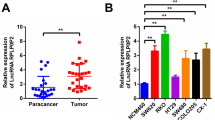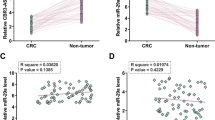Abstract
The function of long non-coding RNA (lncRNA) RPL34-AS1 and microRNA (miR-3656) has been studied in several types of cancer, but their role in colorectal cancer (CRC) is unclear. We predicted that they could interact with each other; this study was carried out to explore their interaction in CRC. The expression of RPL34-AS1 and miR-3656 in CRC tissues and their paired non-tumor tissues from 62 CRC patients was determined by RT-qPCR. The direct interaction between RPL34-AS1 (both WT and mutant) and miR-3656 was determined by RNA-RNA pull-down assay. The interaction between them was studied with overexpression assay. Their role in cell proliferation was analyzed with BrdU assay. The role of RPL34-AS1 in regulating the expression of ACAP2 was explored by RT-qPCR and Western blot analysis. In this study, increased expression levels of miR-3656 and decreased expression levels of RPL34-AS1 were observed in CRC tissues. MiR-3656 directly interacted with RPL34-AS1, but not the RPL34-AS1 mutant with disrupted binding sites. RPL34-AS1 and miR-3565 did not affect the expression of each other. RPL34-AS1 suppressed the role of miR-3565 in enhancing cell proliferation, while RPL34-AS1 mutant did not affect cell behaviors and the role of miR-3565 in cell proliferation. RPL34-AS1 positively regulated the expression of ACAP2 at both mRNA and protein levels. Therefore, RPL34-AS1 is downregulated in CRC and may sponge miR-3656 to suppress cell proliferation in CRC.






Similar content being viewed by others
References
Allemani C, Rachet B, Weir HK, Richardson LC, Lepage C, Faivre J, Gatta G, Capocaccia R, Sant M, Baili P, Lombardo C, Aareleid T, Ardanaz E, Bielska-Lasota M, Bolick S, Cress R, Elferink M, Fulton JP, Galceran J et al (2013) Colorectal cancer survival in the USA and Europe: a CONCORD high-resolution study. BMJ Open 3:e003055
Dai W, Xu Y, Mo S, Li Q, Yu J, Wang R, Ma Y, Ni Y, Xiang W, Han L, Zhang L, Cai S, Qin J, Chen WL, Jia W, Cai G (2020) GLUT3 induced by AMPK/CREB1 axis is key for withstanding energy stress and augments the efficacy of current colorectal cancer therapies. Signal Transduct Target Ther 5:177
De Rosa M, Pace U, Rega D, Costabile V, Duraturo F, Izzo P, Delrio P (2015) Genetics, diagnosis and management of colorectal cancer (Review). Oncol Rep 34:1087–1096
Ducreux M, Chamseddine A, Laurent-Puig P, Smolenschi C, Hollebecque A, Dartigues P, Samallin E, Boige V, Malka D, Gelli M (2019) Molecular targeted therapy of BRAF-mutant colorectal cancer. Ther Adv Med Oncol 11:1758835919856494
Gallagher DJ, Kemeny N (2010) Metastatic colorectal cancer: from improved survival to potential cure. Oncology 78:237–248
Gong Z, Li J, Cang P, Jiang H, Liang J, Hou Y (2019) RPL34-AS1 functions as tumor suppressive lncRNA in esophageal cancer. Biomed Pharmacother 120:109440
Ji L, Fan X, Zhou F, Gu J, Deng X (2020) lncRNA RPL34-AS1 inhibits cell proliferation and invasion while promoting apoptosis by competitively binding miR-3663-3p/RGS4 in papillary thyroid cancer. J Cell Physiol 235:3669–3678
Jin Y, Meng Q, Zhang B, Xie C, Chen X, Tian B, Wang J, Shih T-C, Zhang Y, Cao J, Yang Y, Chen S, Guan X, Chen X, Hong A (2021) Cancer-associated fibroblasts-derived exosomal miR-3656 promotes the development and progression of esophageal squamous cell carcinoma via the ACAP2/PI3K-AKT signaling pathway. International Journal of Biological Sciences 17:3689–3701
Marley AR, Nan H (2016) Epidemiology of colorectal cancer. Int J Mol Epidemiol Genet 7:105–114
Millan M, Merino S, Caro A, Feliu F, Escuder J, Francesch T (2015) Treatment of colorectal cancer in the elderly. World J Gastrointest Oncol 7:204–220
Nishihara R, Wu K, Lochhead P, Morikawa T, Liao X, Qian ZR, Inamura K, Kim SA, Kuchiba A, Yamauchi M, Imamura Y, Willett WC, Rosner BA, Fuchs CS, Giovannucci E, Ogino S, Chan AT (2013) Long-term colorectal-cancer incidence and mortality after lower endoscopy. N Engl J Med 369:1095–1105
Schoen RE, Pinsky PF, Weissfeld JL, Yokochi LA, Church T, Laiyemo AO, Bresalier R, Andriole GL, Buys SS, Crawford ED, Fouad MN, Isaacs C, Johnson CC, Reding DJ, O'Brien B, Carrick DM, Wright P, Riley TL, Purdue MP et al (2012) Colorectal-cancer incidence and mortality with screening flexible sigmoidoscopy. N Engl J Med 366:2345–2357
Siddiqui H, Al-Ghafari A, Choudhry H, Al Doghaither H (2019) Roles of long non-coding RNAs in colorectal cancer tumorigenesis: a review. Mol Clin Oncol 11:167–172
Siegel RL, Miller KD, Goding Sauer A, Fedewa SA, Butterly LF, Anderson JC, Cercek A, Smith RA, Jemal A (2020) Colorectal cancer statistics, 2020. CA Cancer J Clin 70:145–164
Slattery ML, Herrick JS, Mullany LE, Samowitz WS, Sevens JR, Sakoda L, Wolff RK (2017) The co-regulatory networks of tumor suppressor genes, oncogenes, and miRNAs in colorectal cancer. Genes Chromosomes Cancer 56:769–787
Xie YH, Chen YX, Fang JY (2020) Comprehensive review of targeted therapy for colorectal cancer. Signal Transduct Target Ther 5:22
Yang RM, Zhan M, Xu SW, Long MM, Yang LH, Chen W, Huang S, Liu Q, Zhou J, Zhu J, Wang J (2017) miR-3656 expression enhances the chemosensitivity of pancreatic cancer to gemcitabine through modulation of the RHOF/EMT axis. Cell Death Dis 8:e3129
Zhang D, Jiang H, Ye J, Gao M, Wang X, Lu E, Yang H, Wang L, Zhao S (2021) A novel lncRNA, RPL34-AS1, promotes proliferation and angiogenesis in glioma by regulating VEGFA. J Cancer 12:6189–6197
Zhu Y, Ren C, Jiang D, Yang L, Chen Y, Li F, Wang B, Zhang Y (2021) RPL34-AS1-induced RPL34 inhibits cervical cancer cell tumorigenesis via the MDM2-P53 pathway. Cancer Sci 112:1811–1821
Availability of data and martials
The data was available from corresponding author upon reasonable request.
Author information
Authors and Affiliations
Contributions
(I) Conception and design: XL
(II) Administrative support: all authors
(III) Provision of study materials or patients: all authors
(IV) Collection and assembly of data: all authors
(V) Data analysis and interpretation: all authors
(VI) Manuscript writing: CZ, XL
(VII) Final approval of manuscript: all authors
Corresponding author
Ethics declarations
Ethics approval and informed consent
The authors are accountable for all aspects of the work in ensuring that questions related to the accuracy or integrity of any part of the work are appropriately investigated and resolved. For human experiments, the trial was conducted in accordance with the Declaration of Helsinki (as revised in 2013). The study was approved by the human Ethics Committee of the Qingdao Municipal Hospital (Headquarters) and informed consent was taken from all individual participants.
Consent for publication
Not applicable.
Competing interests
The authors declare no competing interests.
Supplementary information
ESM 1
(PDF 317 kb)
ESM 2
(PDF 601 kb)
Supplemental File 1
Top 8 potential miRNAs that can bind RPL34-AS1 (DOCX 57 kb)

Supplemental Figure 1
MiR-3656 targets ACAP2 in two CRC cell lines HT-29 and RKO. The role of miR-3656 in regulating ACAP2 expression in two CRC cell lines HT-29 and RKO was analyzed by performing RT-qPCR and Western blot at mRNA (A) and protein (B) levels, respectively. **, p < 0.01. (PNG 325 kb)
Rights and permissions
About this article
Cite this article
Zhang, C., Zhang, P., Liu, J. et al. LncRNA RPL34-AS1 sponges miR-3656 to suppress cell proliferation in colorectal cancer. In Vitro Cell.Dev.Biol.-Animal 58, 462–470 (2022). https://doi.org/10.1007/s11626-022-00686-7
Received:
Accepted:
Published:
Issue Date:
DOI: https://doi.org/10.1007/s11626-022-00686-7




